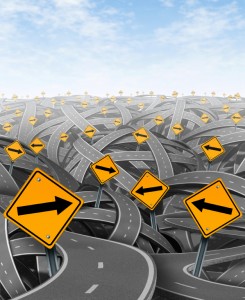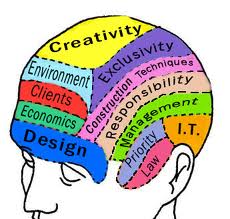Brain Networks – Part 2

Everything is networked.
Yesterday (and in earlier articles here and here), we talked about two brain networks – default and reward – and their implications for organizational behavior. Today, let’s take on two more networks – affect and control – and see how they work in the office. Again, I’ll draw on a recent HBR article by Adam Waytz and Malia Mason.
The affect network activates when people experience emotions. You might think that we consciously recognize something and then feel some emotion about it. That’s true sometimes but often it’s the other way round, with the affect network leading the way. You see a snake and your pulse quickens. Your brain interprets this as fear. Your body – not your brain — reacts to the external stimulus. Your brain reacts to your body’s reaction. (Conceptually, this is similar to System 1 vs. System 2, and thinking with your body).
How does this effect behavior at the office? Well, did your gut ever tell you something? As Waytz and Mason point out, “A hunch is not some mystical sixth sense. It’s a real neurological response that manifests itself physically”. In other words, your affect network is telling you something based on what your body is telling the affect network.
I used to think that I should rationally analyze every key decision and generally ignore my gut feel. Gut feel was irrational and emotional; better to use logic and reason. But Waytz and Mason point out that, “…a mounting body of neurological evidence suggests that emotional impulses should not be ignored. The affect network fast-tracks decision making and helps us process information that may include too many variables.” It’s not obvious how your gut feel reaches your conscious mind, but it often gets there for a good reason. Don’t ignore it.
Finally, there’s the control network that helps people focus their attention and rationally consider long-term decisions. As I understand it, it seems very similar to what Daniel Kahneman calls System 2. The control network “… aligns our brain activity and our behavior with our goals.”
The control network is at the opposite end of the spectrum from the default network. Where the default network activates when you unhook, the control network hooks in and manages all the other networks. The more your have of one, the less you have of the other – similar to focus and creativity.
The control network is rational and also helps us ration our resources. In particular, it rations our attention and helps us focus on those things that are most important to achieving our goals. If you’re like most people, there’s a lot of stuff competing for your attention. As Waytz and Mason put it the control network has “…a tricky attention-management challenge…. On one hand, it needs to prevent distractions from every shiny object thrown in front of us. On the other hand, it needs to let us respond when one of those shiny objects is an opportunity or an important demand”.
The control network has a tough job and can easily get overloaded if there are too many bright shiny objects. This reinforces some traditional wisdom: to execute effectively, organizations should limit their goals to a “manageable few”. It also suggests that we should beware of multitasking. Pursuing multiple tasks at once simply overloads the control network and makes effective rationing impossible. As the authors point out, “Success as a leader requires, first and foremost, creating just a few clear priorities and gathering the courage to eliminate or outsource less important tasks and goals”.
What does all this mean? Well, it’s goes back to what your mother taught you. First, when your emotions tell you something, there’s usually a reason. Second, do only a few things but do them well. It’s nice the neuroscience backs up dear old Mom.
Brain Networks At The Office

Quick! Activate the default network!
When you’re “zoned out”, your brain’s default network kicks in and processes stuff. What kind of stuff? Well, not new stuff because you’re zoned out and no new stuff is coming in. You’ve unhooked yourself from the grid and the only thing your brain can work on is stuff that’s already in your brain. It’s like mentally chewing your cud.
It turns out the default network contributes in very important ways to creativity. As Adam Waytz and Malia Mason point out in a recent issue of Harvard Business Review, the default network is “… responsible for one of our most prized abilities: transcendence. The capacity to envision what it’s like to be in a different place, a different time, a different person’s head, or a different world altogether is unique to humans….”
To create creative environments, managers are beginning to realize the importance of allowing employees to “unhook” and activate their default networks. Unfocused free time is critical to creative thinking and innovation. As I’ve pointed out before, too much focus can kill creativity. Waytz and Mason point out that many of the “creative time off” programs at companies like Google may still miss the mark. They focus on quantity of time off, rather than quality. The authors argue that it may be better to focus on “total detachment” rather than the number of days off. The idea is to “unfocus” and activate the default network rather than to shift focus to a project of personal interest.
In addition to the default network, Waytz and Mason identify three other brain networks that can contribute to improved performance and productivity. These are: the reward network, the affect network, and the control network. Let’s look at the reward network today. We’ll visit the affect and control networks tomorrow.
Waytz and Mason compare the reward network to a hedonometer, a hypothetical instrument that could “…measure the amount of pleasure or displeasure we feel in response to any stimulus”. The reward network “…reliably activates in response to things that evoke enjoyment and deactivates in response to things that reduce enjoyment”.
In animals, the reward network activates when the animal encounters something– like food or water — that has clear survival value. The same is true of humans. But there’s more to the human reward system. Unlike animals, the human reward system activates for “secondary” rewards – those that have no direct survival value.
Money is clearly an important secondary reward, but numerous, non-monetary secondary rewards also exist. Some are obvious, like status and recognition. Others are less obvious, like fairness. Waytz and Mason argue that employees’ reward systems light up when they perceive their organization to be fair. When the organization is perceived to be unfair, the reward system dims and employees lose motivation. This is true both for employees who benefit from the unfairness and for those who suffer from it. As Waytz and Mason put it, “A fair environment is a reward to people regardless of their standing”.
So how do you fine tune the reward system? Both fairness and transparency are important. Somewhat surprisingly, so is the expectation of learning. When employees expect that they will learn something, the reward system activates and motivation rises. Goals are also important but Waytz and Mason argue that broad goals that provide employees some room to maneuver activate the reward network more effectively than narrowly defined, overly stringent goals that leave little room for judgment.
And what about money? Well, it can be useful. But Waytz and Mason conclude that, “Any number of things employers can do ‘on the cheap’—fostering a culture of fairness and cooperation, offering opportunities for people to engage their curiosity, and providing plenty of social approval—will motivate employees as much if not more [than money]”. So think about money in your reward structure … but not too much.
Daydreaming, Default Networks, and Creativity
 Is your mind ever really at rest? Does it ever switch completely off? Apparently not. Something is always going on. You may be focused or unfocused, thinking or dreaming, but something is always happening.
Is your mind ever really at rest? Does it ever switch completely off? Apparently not. Something is always going on. You may be focused or unfocused, thinking or dreaming, but something is always happening.
When we’re engaged in an attention-absorbing activity (AAA) – and especially a pleasurable AAA – the task-positive network kicks in. It helps us stay focused, pay attention, and accomplish specific tasks. It generally keeps us conscious of what we’re doing.
When we’re not engaged in an AAA, the default network kicks in, allowing our mind to wander. We can daydream, think about the future, “correct” mistakes we made in the past, and generally “zone out”. It’s what happens when your mind wanders away while reading or driving. It’s “negatively correlated” with parts of the brain that process visual stimuli, which may very well be related to inattentional blindness.
On average, some 30% of our waking time is devoted to daydreaming. The default network switches on and the task-positive network switches off. (They can’t both be on at the same time). Often, we are not aware that we are daydreaming, unless someone asks, a penny for your thoughts. Then we realize that we were somewhere else. Researchers on daydreaming essentially offer a penny for your thoughts at random intervals.
Why would we spend so much time daydreaming? It’s not completely clear. But people who have suffered long-term stress (like PTSD or child abuse) or who have some forms of autism seem to have difficulty activating their default network and daydreaming. As Josie Glausiusz writes in Scientific American, “The default network appears to be essential to generating our sense of self, suggesting that daydreaming plays a crucial role in who we are and how we integrate the outside word into our inner lives.”
Daydreaming may also be related to creativity. Researchers at UC Santa Barbara used the Unusual Uses Task (UUT) to measure creativity under different conditions. (The UUT present you with a common object – like a brick – and asks you to come up with as many unusual uses as possible). The researchers found that “higher levels of mind wandering” were associated with improved performance on the UUT. On the other hand, thinking specifically about the UUT did not improve performance.
To promote creativity through daydreaming, however, it appears that we need to be conscious of our daydreaming. That’s not as easy as it sounds. When I’m daydreaming, I am indeed zoned out and the bright ideas I get while in that zone may never pop into my consciousness. The trick seems to be to ask the penny for your thoughts question of yourself. As you return from your daydream, think about what you were thinking about and capture it consciously. You may find a good solution to a problem … or a good topic for your blog.